Читать книгу Successful Compliance - Barbara Neiger - Страница 10
1.1DEFINITION OF THE TERM ‘COMPLIANCE’
ОглавлениеThe term ‘compliance’ is derived[1] from the verb ‘to comply with something’, and in the context of this manual means the observance of rules by an organisation – that is, those rules that are binding for the organisation due to statutory provisions, as well as those to whose compliance the organisation has voluntarily submitted.
Under this definition, compliance requires first of all only that all obligations are met. This is nothing new and is a self-evident principle in states governed by the rule of law.[2] However, compliance also includes the issue of how organisations ensure that their statutory bodies and employees comply with rules. It is the responsibility of the competent managers to ensure, as part of their supervisory duty and due diligence, that people who work for organisations comply with statutory requirements, industry regulations and corporate policies in everyday business transactions.
The obligation to comply with legal regulations applies to all organisations. Also compliance with industry regulations and internal policies is not an end in itself, but is in the interest of the organisation. All organisations, irrespective of their legal form, size or field of activity, have only limited resources at their disposal. These must be deployed as efficiently and effectively as possible. It is not correct to argue that the requirement for such economic actions applies only to for-profit organisations. Non-profit organisations, too, have limited resources at their disposal, which must be deployed to achieve the best possible result. Negative financial consequences of non-compliance, in the form of penalties and fines, certainly do not fall within the definition of the ‘best possible result’.
